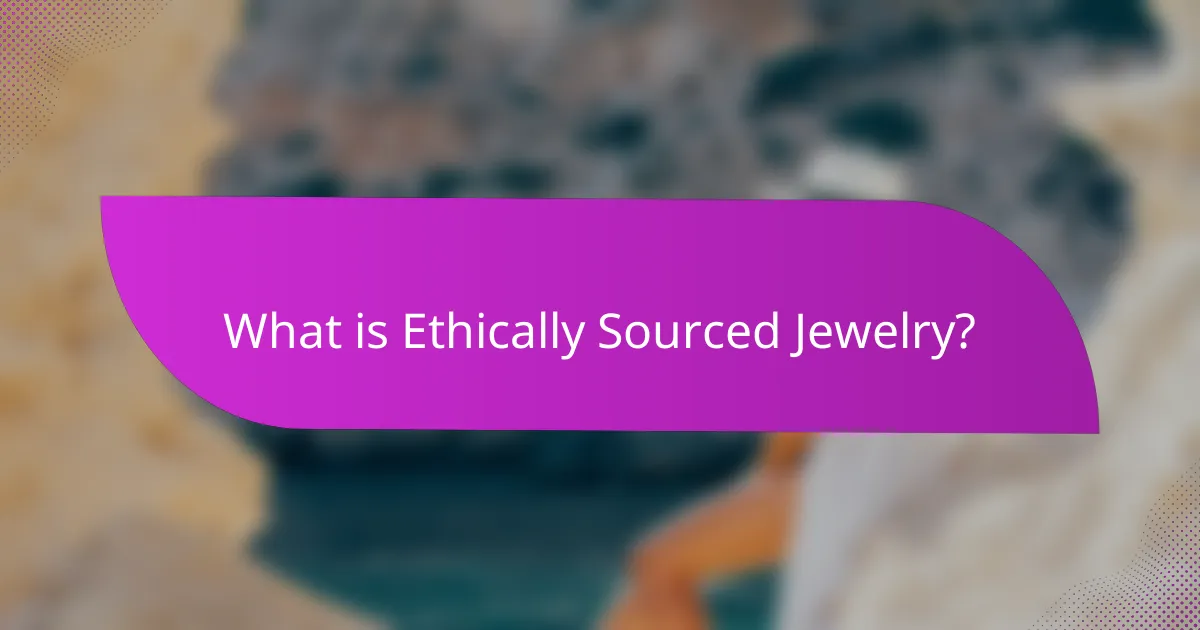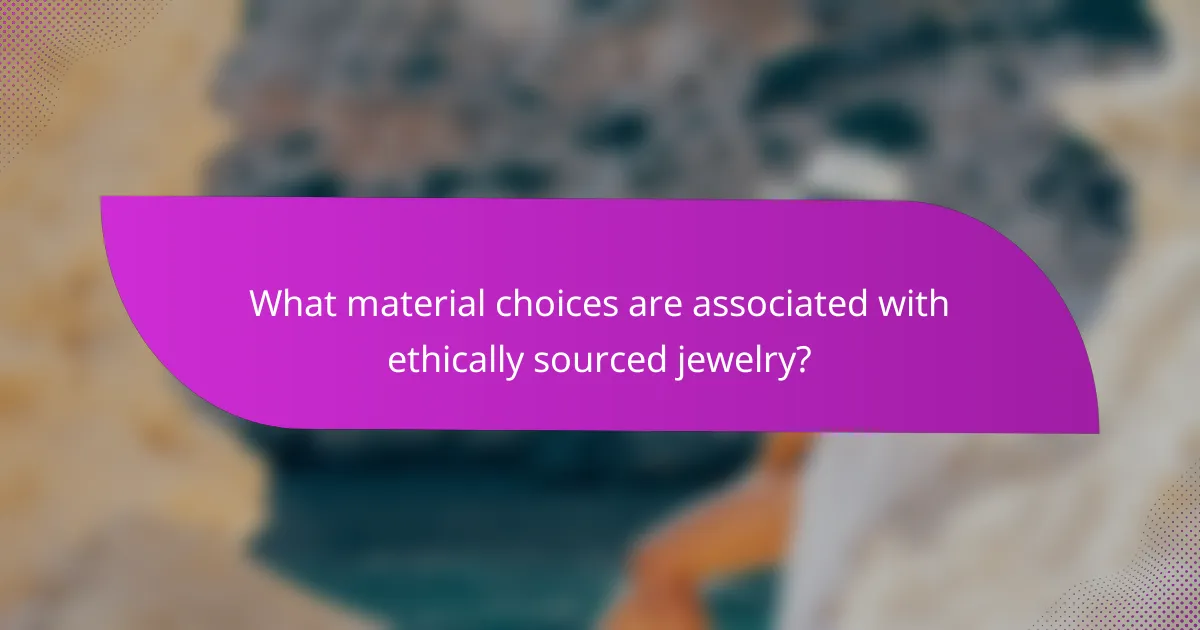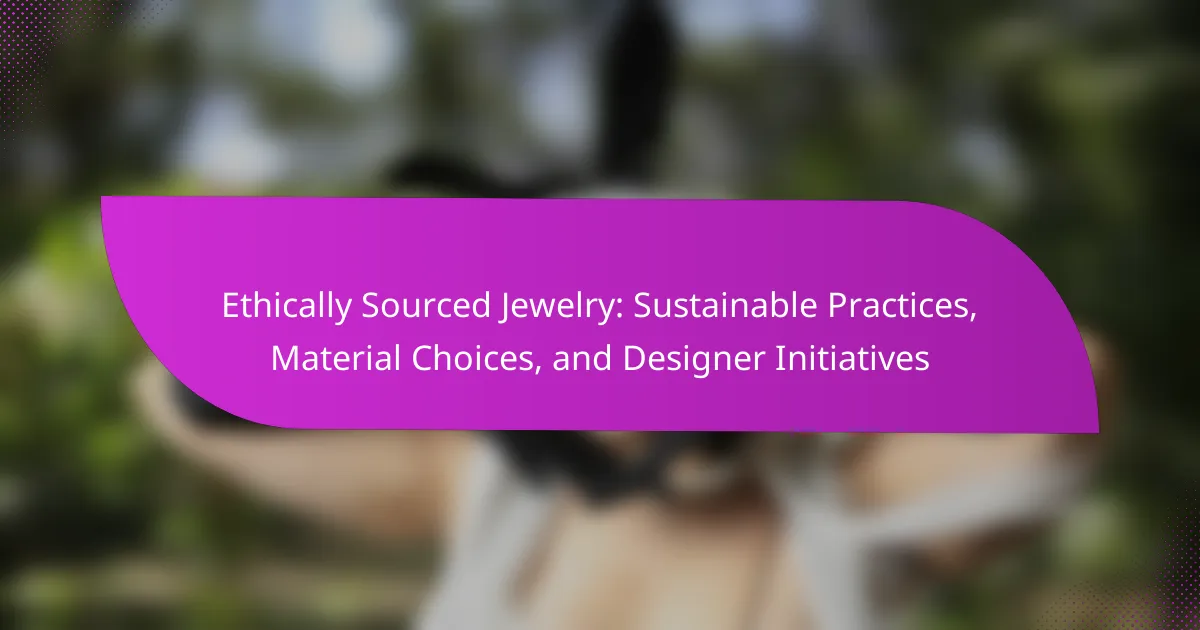Ethically sourced jewelry refers to jewelry made from materials acquired through responsible and sustainable practices, ensuring fair labor and environmental protection. This article explores the principles of ethical sourcing, including the use of recycled metals, lab-grown gemstones, and fair-trade diamonds, which minimize environmental impact and promote social responsibility. It highlights the importance of transparency in supply chains and the role of certifications from organizations like the Responsible Jewelry Council. Additionally, the article discusses initiatives by jewelry designers to adopt sustainable practices, educate consumers, and collaborate with ethical organizations, contributing to a more sustainable jewelry industry.

What is Ethically Sourced Jewelry?
Ethically sourced jewelry is jewelry made from materials acquired in a responsible and sustainable manner. This includes ensuring fair labor practices and environmental protection during the sourcing process. Ethical sourcing often involves transparency in the supply chain. It seeks to avoid conflict minerals and exploitative labor conditions. Many brands provide certifications to prove their ethical claims. For example, the Responsible Jewelry Council offers standards for ethical practices. Additionally, ethically sourced jewelry often incorporates recycled materials. This approach reduces environmental impact and promotes sustainability.
Why is ethical sourcing important in the jewelry industry?
Ethical sourcing is important in the jewelry industry to ensure responsible practices in material acquisition. It helps prevent human rights abuses, such as child labor and exploitation in mining operations. Ethical sourcing promotes sustainability by reducing environmental damage caused by mining activities. It encourages transparency in the supply chain, allowing consumers to make informed choices. According to a 2020 survey by the Ethical Consumer, 70% of consumers prefer brands that prioritize ethical sourcing. This shift in consumer demand drives brands to adopt more responsible practices. Ultimately, ethical sourcing fosters trust between consumers and brands, enhancing brand reputation.
How does ethical sourcing impact the environment?
Ethical sourcing positively impacts the environment by promoting sustainable practices. It encourages the use of materials that are responsibly extracted. This reduces habitat destruction and pollution associated with mining and production. Ethical sourcing also prioritizes renewable resources over non-renewable ones. Studies show that companies adopting ethical sourcing see a decrease in their carbon footprint. For instance, sourcing recycled metals significantly lowers energy consumption. Additionally, ethical sourcing often supports biodiversity conservation efforts. This approach helps maintain ecosystems that are vital for environmental health. Overall, ethical sourcing fosters a more sustainable and environmentally friendly industry.
What are the social implications of ethically sourced jewelry?
Ethically sourced jewelry promotes social responsibility and community well-being. It supports fair labor practices, ensuring workers receive fair wages and safe working conditions. This practice reduces exploitation in the mining and production processes. Ethically sourced jewelry often empowers marginalized communities through economic development. It fosters transparency in supply chains, allowing consumers to make informed choices. Research indicates that ethical sourcing can improve local economies by providing sustainable livelihoods. For example, a study by the Ethical Trading Initiative shows that ethical practices can enhance community welfare. Thus, ethically sourced jewelry has significant positive social implications.
What are the key principles of ethical sourcing?
The key principles of ethical sourcing include transparency, fair labor practices, and environmental responsibility. Transparency ensures that companies disclose their supply chain processes. Fair labor practices involve providing safe working conditions and fair wages to workers. Environmental responsibility focuses on minimizing ecological impact during production. These principles help build trust with consumers and promote sustainability in sourcing practices. Research shows that 66% of consumers are willing to pay more for sustainable brands. This highlights the importance of ethical sourcing in modern consumer behavior.
How do transparency and traceability play a role?
Transparency and traceability are crucial for ensuring ethical sourcing in jewelry. They allow consumers to verify the origins of materials used in the products. Transparent practices involve clear communication about sourcing methods and supply chains. Traceability enables tracking of materials from their source to the final product. This process helps to identify and eliminate unethical practices, such as conflict mining or exploitation. According to a 2021 report by the Responsible Jewelry Council, 70% of consumers prefer brands that provide information about their sourcing practices. By fostering trust, transparency and traceability enhance brand loyalty and consumer confidence.
What standards define ethically sourced materials?
Ethically sourced materials are defined by standards that ensure environmental sustainability and social responsibility. These standards often include certifications such as Fair Trade, which guarantees fair wages and safe working conditions for workers. Additionally, the Responsible Jewelry Council provides guidelines for sourcing materials with minimal environmental impact. The use of recycled materials also aligns with ethical sourcing by reducing waste and resource depletion. Transparency in the supply chain is crucial, allowing consumers to trace the origin of materials. Compliance with local and international labor laws further supports ethical sourcing practices. These standards collectively promote a sustainable and equitable approach to material sourcing in industries like jewelry.

What sustainable practices are involved in ethically sourced jewelry?
Sustainable practices in ethically sourced jewelry include responsible material sourcing and fair labor practices. Responsible material sourcing ensures that precious metals and gemstones are mined with minimal environmental impact. This often involves using recycled materials or sourcing from certified mines that adhere to environmental regulations. Fair labor practices guarantee safe working conditions and fair wages for artisans and miners. Additionally, many brands implement transparency in their supply chains. This allows consumers to trace the origins of materials used. Eco-friendly packaging and reduced carbon footprints are also common practices. These initiatives collectively contribute to a more sustainable jewelry industry.
How do sustainable mining practices differ from traditional methods?
Sustainable mining practices prioritize environmental protection and community welfare, unlike traditional methods. Traditional mining often leads to habitat destruction and pollution. In contrast, sustainable practices focus on minimizing ecological impact. They employ techniques like reduced water usage and waste management. Sustainable mining also emphasizes social responsibility, ensuring fair labor practices. This approach often involves community engagement and investment in local economies. For example, companies may support education and healthcare in mining regions. Overall, sustainable practices aim for a balance between resource extraction and environmental stewardship.
What technologies are used to promote sustainable mining?
Technologies used to promote sustainable mining include advanced data analytics, remote sensing, and automation. Advanced data analytics helps optimize resource extraction while minimizing environmental impact. Remote sensing technology allows for real-time monitoring of mining operations. Automation improves efficiency and reduces the need for manual labor in hazardous environments. Additionally, water recycling systems are employed to minimize water usage. Renewable energy sources, such as solar and wind, power mining operations to reduce carbon footprint. These technologies collectively contribute to more sustainable mining practices.
How do sustainable practices reduce environmental impact?
Sustainable practices reduce environmental impact by minimizing resource depletion and pollution. They promote the use of renewable resources. For example, sustainable jewelry often uses recycled metals and ethically sourced gemstones. This reduces the need for mining, which can harm ecosystems. Additionally, sustainable practices encourage energy efficiency. Using solar power in production decreases carbon emissions. Studies show that sustainable methods can cut waste by up to 90%. This leads to less landfill overflow and lower environmental degradation. Overall, sustainable practices create a more balanced relationship with nature.
What role does recycling play in sustainable jewelry practices?
Recycling plays a crucial role in sustainable jewelry practices by reducing the demand for newly mined materials. It minimizes environmental impact by conserving natural resources and decreasing energy consumption associated with mining. According to the World Gold Council, recycling gold can save up to 90% of the energy required for new extraction. Additionally, recycled materials help reduce waste in landfills, promoting a circular economy. The use of recycled metals and gemstones also contributes to lower carbon footprints in jewelry production. Overall, recycling supports sustainability by fostering responsible sourcing and manufacturing practices.
How can recycled materials be used in jewelry design?
Recycled materials can be creatively incorporated into jewelry design. Designers often use reclaimed metals, such as silver and gold, which reduce mining impact. Glass from bottles can be transformed into stunning beads or pendants. Additionally, fabric scraps can be woven into unique pieces or used as accents.
Using recycled materials promotes sustainability and reduces waste. According to the World Gold Council, using recycled gold can lower the environmental footprint by up to 99%. Jewelry made from recycled materials often tells a story, adding emotional value. This approach aligns with growing consumer demand for ethical and sustainable products.
What are the benefits of using recycled metals and stones?
Using recycled metals and stones reduces environmental impact significantly. It conserves natural resources by minimizing the need for new extraction. Recycling metals can save up to 95% of the energy required to produce new metals. This process also reduces greenhouse gas emissions associated with mining and processing. Additionally, using recycled materials lowers waste in landfills. It promotes a circular economy by repurposing existing materials. Recycled metals and stones maintain high quality and aesthetic appeal. Sustainable practices in jewelry sourcing encourage ethical consumerism.

What material choices are associated with ethically sourced jewelry?
Ethically sourced jewelry typically utilizes materials such as recycled metals, lab-grown gemstones, and fair-trade diamonds. Recycled metals reduce the need for new mining and lower environmental impact. Lab-grown gemstones are created in controlled environments, ensuring ethical production without harmful mining practices. Fair-trade diamonds are sourced from mines that adhere to ethical labor practices and environmental standards. These material choices reflect a commitment to sustainability and social responsibility in the jewelry industry.
What types of materials are considered ethically sourced?
Ethically sourced materials include recycled metals, conflict-free diamonds, and sustainably harvested gemstones. Recycled metals reduce environmental impact by reusing existing resources. Conflict-free diamonds are sourced from mines that do not finance violence or human rights abuses. Sustainably harvested gemstones come from practices that protect ecosystems and communities. These materials are often certified by organizations that ensure ethical practices. Examples include the Responsible Jewelry Council and Fair Trade certifications. These certifications verify that sourcing meets specific ethical standards.
How do lab-grown diamonds compare to mined diamonds?
Lab-grown diamonds are chemically and physically identical to mined diamonds. Both types are composed of carbon atoms arranged in a crystal structure. However, lab-grown diamonds are created in controlled environments, while mined diamonds form naturally over millions of years.
Lab-grown diamonds typically cost 20-40% less than mined diamonds due to lower production costs. The environmental impact of lab-grown diamonds is significantly lower, as they do not require extensive mining operations. Additionally, lab-grown diamonds are conflict-free, ensuring ethical sourcing.
Research indicates that lab-grown diamonds have the same optical properties as their mined counterparts. A study by the Gemological Institute of America (GIA) confirms that both types can be graded using the same criteria. This makes lab-grown diamonds a viable alternative for consumers seeking sustainable options.
What are the benefits of using alternative gemstones?
Alternative gemstones offer several benefits. They promote sustainability by reducing the demand for mined gemstones. This helps to minimize environmental degradation associated with mining activities. Alternative gemstones often come from ethical sources, ensuring fair labor practices. They can be more affordable than traditional gemstones, making them accessible to a wider audience. Additionally, alternative gemstones come in a variety of colors and unique characteristics, allowing for diverse design options. Their use supports local economies in areas where these stones are sourced. By choosing alternative gemstones, consumers can express individuality while supporting ethical practices.
What certifications should consumers look for in ethically sourced jewelry?
Consumers should look for certifications such as Fair Trade, Responsible Jewelry Council (RJC), and Kimberley Process. Fair Trade certification ensures fair wages and safe working conditions for miners. The Responsible Jewelry Council promotes ethical, social, and environmental practices in the jewelry supply chain. The Kimberley Process aims to prevent conflict diamonds from entering the market. These certifications provide assurance about the ethical sourcing of materials used in jewelry. They help consumers make informed choices that align with their values.
How do certifications ensure ethical practices in sourcing?
Certifications ensure ethical practices in sourcing by establishing standardized criteria for responsible sourcing. These criteria often include guidelines on labor rights, environmental impact, and fair trade practices. For example, certifications like Fair Trade and Responsible Jewellery Council require companies to meet specific ethical standards. Compliance is verified through audits and assessments. This process promotes transparency in the supply chain. It also helps consumers identify products that align with their values. Studies show that certified products often lead to improved working conditions and sustainable practices. Thus, certifications play a vital role in promoting ethical sourcing.
What are some reputable certification organizations?
Some reputable certification organizations include the Responsible Jewellery Council (RJC) and Fair Trade Jewelry Co. The Responsible Jewellery Council focuses on ethical practices in the jewelry supply chain. Fair Trade Jewelry Co. ensures fair wages and safe working conditions for artisans. Additionally, the Kimberley Process Certification Scheme aims to prevent the trade of conflict diamonds. These organizations are recognized for their commitment to sustainability and ethical sourcing in the jewelry industry.

What initiatives are being taken by jewelry designers to promote ethical sourcing?
Jewelry designers are implementing various initiatives to promote ethical sourcing. Many designers are adopting transparent supply chains. This allows consumers to trace the origins of materials used in their products. Additionally, some designers are using recycled metals and ethically sourced gemstones. This reduces the environmental impact and supports responsible mining practices. Furthermore, collaborations with organizations like Fair Trade and the Responsible Jewelry Council are becoming common. These partnerships help ensure adherence to ethical standards. Designers are also educating consumers about the importance of ethical sourcing. This awareness can drive demand for responsibly sourced jewelry.
How are designers incorporating ethical practices into their brands?
Designers are incorporating ethical practices into their brands by using sustainable materials. They prioritize eco-friendly sourcing to minimize environmental impact. Many designers choose recycled metals and ethically mined gemstones. This approach reduces harm to ecosystems and supports responsible mining practices. Additionally, designers promote fair labor practices in their supply chains. They ensure workers receive fair wages and safe working conditions. Transparency is also key; brands disclose their sourcing methods to build consumer trust. Collaborative initiatives with non-profits further enhance their ethical commitments. These actions reflect a growing demand for responsible fashion in the jewelry industry.
What are some examples of designers leading the way in ethical sourcing?
Some examples of designers leading the way in ethical sourcing include Stella McCartney and Eileen Fisher. Stella McCartney is known for her commitment to sustainable materials and cruelty-free practices. She uses organic cotton, recycled polyester, and sustainable viscose in her collections. Eileen Fisher emphasizes fair trade practices and sustainable fibers like organic linen and Tencel. Both designers have received recognition for their contributions to ethical fashion. Their initiatives showcase a growing trend towards responsible sourcing in the fashion industry.
How do collaborations with NGOs enhance ethical practices?
Collaborations with NGOs enhance ethical practices by providing guidance and expertise in sustainability. NGOs often have extensive knowledge of ethical sourcing and environmental standards. They help jewelry designers align their practices with these standards. This collaboration can improve transparency in supply chains. NGOs also facilitate training for artisans on fair labor practices. Additionally, they can assist in community development initiatives. These efforts contribute to better working conditions and fair wages. Research shows that brands partnering with NGOs report higher consumer trust and loyalty.
What challenges do designers face in sourcing materials ethically?
Designers face significant challenges in sourcing materials ethically. One major challenge is the lack of transparency in supply chains. Many suppliers do not disclose their sourcing practices. This makes it difficult for designers to verify the ethical origins of materials. Another challenge is the higher cost of ethically sourced materials. Sustainable options often come at a premium price. This can limit accessibility for designers working within budget constraints. Additionally, there is the issue of certification and standards. Not all ethical certifications are recognized universally. This creates confusion for designers trying to ensure compliance. Finally, designers may encounter limited availability of ethically sourced materials. The demand for sustainable options is growing but supply often lags behind. These factors collectively complicate the process of ethical sourcing for designers.
How can designers overcome obstacles in ethical sourcing?
Designers can overcome obstacles in ethical sourcing by implementing transparent supply chains. This involves collaborating with suppliers who adhere to ethical practices. Establishing clear communication with these suppliers ensures accountability. Designers can also conduct regular audits to verify compliance with ethical standards. Utilizing certifications like Fair Trade can aid in identifying responsible sources. Engaging in direct trade with artisans fosters fair wages and sustainable practices. Additionally, investing in sustainable materials reduces environmental impact. Education on ethical sourcing for both designers and consumers promotes informed choices.
What resources are available to support ethical jewelry initiatives?
Resources available to support ethical jewelry initiatives include certifications, organizations, and educational materials. Certifications like Fair Trade and Responsible Jewelry Council provide guidelines for ethical sourcing. Organizations such as the Ethical Metalsmiths and the Alliance for Responsible Mining advocate for sustainable practices. Educational materials from these organizations help designers and consumers understand ethical standards. Additionally, funding opportunities from grants and ethical investment firms support sustainable jewelry projects. These resources collectively promote transparency and accountability in the jewelry industry.
What practical tips can consumers follow to support ethically sourced jewelry?
Consumers can support ethically sourced jewelry by researching brands. Look for companies that provide transparency about their sourcing practices. Check if they use recycled materials or conflict-free gems. Verify if they are certified by ethical organizations. Choose brands that prioritize fair labor practices for their artisans. Support local artisans who create handmade pieces. Attend ethical jewelry fairs to discover new designers. Share information about ethical brands on social media to raise awareness. These actions contribute to a more sustainable and responsible jewelry market.
Ethically sourced jewelry is defined as jewelry made from materials obtained through responsible and sustainable practices, ensuring fair labor and environmental protection. This article explores the importance of ethical sourcing in the jewelry industry, its environmental and social implications, and the key principles that guide these practices. It discusses the role of certifications, the use of recycled materials, and sustainable mining technologies, along with examples of designers leading the way in ethical sourcing. Additionally, practical tips for consumers to support ethically sourced jewelry are provided, highlighting the growing demand for transparency and responsibility in the market.
